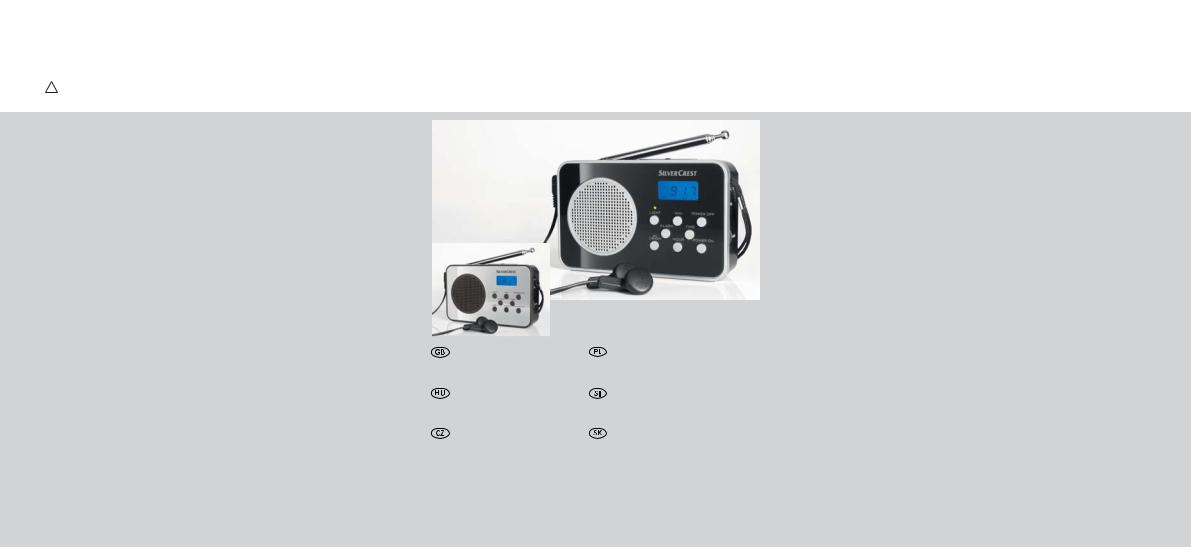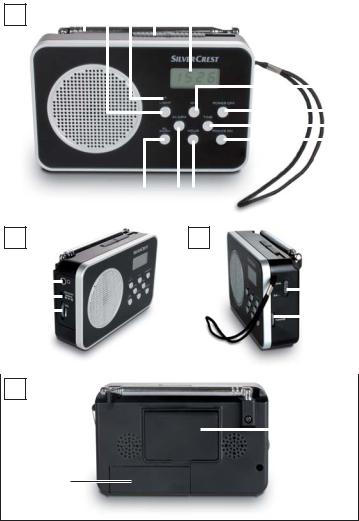Silvercrest SWED 100 A1 User Manual [en, pl, cs]

|
|
|
|
|
|
|
|
|
|
4 |
Multi-Band Radio SWED 100 A1 |
|||
|
|
|
|
|
|
|
|
|
|
|
|
|
|
|
|
|
|
|
|
|
|
|
|
|
KOMPERNASS GMBH
BURGSTRASSE 21 · D-44867 BOCHUM www.kompernass.com
ID-Nr.: SWED 100 A1-12/10-V3
IAN: 61893
Multi-Band Radio |
Odbiornik wielopasmowy |
Operating instructions |
Instrukcja obsługi |
Világvevő rádió |
Svetovni sprejemnik |
Használati utasítás |
Navodila za uporabo |
Rádio |
Rádioprijímač |
Návod k obsluze |
Návod na obsluhu |

A |
|
|
|
|
|
|||||||||||||||||
|
|
|
|
|
|
|
|
|
|
|
|
|
|
|
|
|
|
|
|
|
|
|
|
|
|
|
|
|
|
|
|
|
|
|
|
|
|
|
|
|
|
|
|
|
|
|
|
|
|
|
|
|
|
|
|
|
|
|
|
|
|
|
|
|
|
|
|
|
|
|
|
|
|
|
|
|
|
|
|
|
|
|
|
|
|
|
|
|
|
|
|
|
|
|
|
|
|
|
|
|
|
|
|
|
|
|
|
|
|
|
|
|
|
|
|
|
|
|
|
|
|
|
|
|
|
|
|
|
|
|
|
|
|
|
|
|
|
|
|
|
|
|
|
|
|
|
|
|
|
|
|
|
|
|
|
|
|
|
|
|
|
|
|
|
|
|
|
|
|
|
|
|
|
|
|
|
|
|
|
|
|
|
|
|
|
|
|
|
|
|
|
|
|
|
|
|
|
|
|
|
|
|
|
|
|
|
|
|
|
|
|
|
|
|
|
|
|
|
|
|
|
|
|
|
|
|
|
|
|
|
|
|
|
|
|
|
|
|
|
|
|
|
|
|
|
|
|
|
|
|
|
|
|
|
|
|
|
|
|
|
|
|
|
|
|
|
|
|
|
|
|||||
|
|
|
|
|
|
|||||||||||||||||
|
|
|
|
|
|
|
|
|
|
|
|
|
|
|
|
|
|
|
|
|
|
|
|
|
|
|
|
|
|
|
|
|
|
|
|
|
|
|
|
|
|
|
|
|
|
B |
|
|
|
|
|
|
|
|
|
|
|
|
C |
|
|
|
|
|
|
|||
|
|
|
|
|
|
|
|
|
|
|
|
|
|
|
|
|
|
|
|
|
|
|
|
|
|
|
|
|
|
|
|
|
|
|
|
|
|
|
|
|
|
|
|
||
|
|
|
|
|
|
|
|
|
|
|
|
|
|
|
|
|
|
|
|
|
||
|
|
|
|
|
|
|
|
|
|
|
|
|
|
|
|
|
|
|
|
|
|
|
|
|
|
|
|
|
|
|
|
|
|
|
|
|
|
|
|
|
|
|
|
||
|
|
|
|
|
|
|
|
|
|
|
|
|
|
|
|
|
|
|
|
|
|
|
|
|
|
|
|
|
|
|
|
|
|
|
|
|
|
|
|
|
|
|
|
|
|
|
|
|
|
|
|
|
|
|
|
|
|
|
|
|
|
|
|
|
|
|
||
|
|
|
|
|
|
|
|
|
|
|
|
|
|
|
|
|
|
|
|
|
|
|
|
|
|
|
|
|
|
|
|
|
|
|
|
|
|
|
|
|
|
|
|
|
|
|
|
|
|
|
|
|
|
|
|
|
|
|
|
|
|
|
|
|
|
|
|
|
D |
|
|
|
|
|
|
|
|
|
|
|
|
|
|
|
|
|
|
|
|
|
|
|
|
|
|
|
|
|
|
|
|
|
|
|
|
|
|
|
|
|
|
|
|
|
|
|
|
|
|
|
|
|
|
|
|
|
|
|
|
|
|
|
|
|
|
||

CONTENT |
PAGE |
|
|
Intended use |
2 |
|
|
Items supplied |
2 |
|
|
Technical data |
3 |
|
|
Appliance description |
4 |
|
|
Safety instructions |
5 |
|
|
Power supply |
6 |
|
|
Setup |
7 |
|
|
Receive Mode |
7 |
|
|
Time and alarm function |
8 |
|
|
Cleaning and storage |
9 |
|
|
Maintenance |
9 |
|
|
Troubleshooting |
10 |
|
|
Disposal |
10 |
|
|
Warranty and Service |
11 |
|
|
Importer |
12 |
Read these operating instructions carefully before using the appliance for the first time and preserve this booklet for future reference. Pass this booklet on to whoever might acquire the appliance at a future date.
- 1 -

MULTI-BAND RADIO
This documentation is copyright protected. Every duplication resp. every copying, also as extracts, as well as any reproduction of images, even in an altered state, is only permitted with the written consent of the manufacturer.
Intended use
This device is intended for receiving generally approved radio transmissions in all countries (world receiver) and only for household use.
Utilisation other than as described here is not permitted and it could lead to damages and injuries. No liability will be accepted for damages resulting from misuse or improper handling, the application of force or unauthorised modifications.
Items supplied
1 x Radio
1 x Storage bag
1 x Earphones
2 x Batteries, Mignon 1.5V Type AA
1 x Operating instruction
•Check to ensure that the appliance is undamaged, all component parts are present and that all packaging remnants are removed from it.
Note: An adaptor for mains operation is not supplied, but can be obtained from a specialist shop. Take note of the details listed for the mains power adaptor in the section "Technical data".
- 2 -

Technical data
a) Reception ranges: |
|
FM (VHF): |
87.5 – 108 MHz |
AM (MW): |
526.5 – 1606.5 kHz |
SW 1-7 (KW): |
5.95 – 15.6 MHz |
b) Restrictions for climatic zones: |
|
Temperatures: |
-5 – +40°C |
Relative humidity: |
20 – 80% relative humidity |
c) Miscellaneous: |
|
Output power: |
approx. 100 mW +/- 10% |
Earphone connection: |
3.5 mm jackplug socket |
Max. output level f. |
|
earphone socket: |
approx. 60 mV |
Batteries: |
2 x 1.5 V Type “AA” Mignon |
Mains adaptor: |
optional, DC 3.6 V / 200 mA |
Connection for mains adaptor: |
Barrel plug 3.5/1.3mm, plus innen |
Dimensions: |
123 x 35 x 75 mm |
Weight : |
approx. 150 g (Radio, without batteries), |
|
10 g Storage bag |
d) Earphone: |
|
Wideband characteristic |
|
voltage (WBCV): |
200 mV |
Type: |
SWED100A1E |
Impedance: |
32 Ω |
CEConformity
This device has been tested and approved in accordance with the basic requirements and other relevent regulations of the EMV directive 2004/108/EC.
- 3 -

Appliance description
Figure A:
Telescopic antenna
"LIGHT" button: Switch display lighting on
POWER LED: indicates that the device is switched on
Waveband Selector Switch: Select FM, AM and SW reception rangesDisplay
"MIN" button: Set the minutes
"POWER OFF" button: Switch the device off "TIME" button: To set the time
"POWER ON" Button: Switch the device on"HOUR" button: Set the hours
"ALARM" button: Set the alarm
"AL. ON/OFF" button: Switch the alarm function On/Off
Figure B:
Headphones connection socket
Power supply socket for AC adapter (optional)Volume controller "VOL"
Figure C:
Slider switch "LOCAL/DX": Adjust reception sensitivityTuning regulator "TUNING"
Figure D:
Stand: Stand the device at an angleBattery compartment
- 4 -

 Safety instructions
Safety instructions
•The technical actualities of the device permit an adjustable frequency range outside the permissible ranges of 87.5 to 108 MHz, 526.5 to 1606.5 kHz resp. 5.95 to 15.6 MHz. In some countries, different national regulations may apply to the assigned radio frequency ranges. Please note that information received outside of the assigned radio frequency ranges may not be used, passed on to third parties or otherwise misused.
•Transportable world receivers are used in a wide range of climate zones. Pay heed, especially when used outdoors, that the climatic restrictions (see Technical data) are not exceeded. Electronic devices can be damaged by moisture. Extremely dry air can initiate static charges that could lead to faulty functions. Very high temperatures (e.g. direct sunlight) or very low temperatures (e.g. outdoors in winter) can permanently darken the liquid crystal display.
•Transportable appliances are particularly at risk from accidental damage. Protect the appliance against heavy stresses, such as impacts and falls. Select a location in your travel luggage where it cannot be damaged, or switched on, by other hard objects.
•Protect the appliance against drip and spray water. Do not place waterfilled receptacles, such as flower vases, on or next to the appliance.
•Never submerge the appliance in water or other liquids. This could damage it irreparably!
•Batteries may not be thrown into a fire, taken to pieces or short circuited. Additionally, do not attempt to recharge batteries. There is a chance that they could explode.
•Always store batteries at a location that in inaccessible for small children and infants. Should a battery be swallowed, seek medical attention IMMEDIATELY.
- 5 -

•Check to ensure that the appliance is in a serviceable condition before taking it into use. Should there be visible damage to the appliance, do not take it into use. Arrange for it to be checked for safety by Customer Services.
Attention!
Listening to music with earphones for long periods and at high volume levels can lead to hearing damage!
•Use only the supplied headphones of Type SWED100A1E.
When using headphones, the built-in loudspeakers are switched off.
Power supply
a) Inserting the batteries:
•Open the battery compartment on the rear of the appliance and insert two batteries as shown on the markings next to the battery compartment. Close the battery compartment. The appliance is now ready for use.
•When a battery symbol appears in the display , always replace both batteries with the types detailed under Technical Data. In this regard, also take note of the notices contained in the sections “Maintenance” and “Disposal”.
Take note: If the battery symbol appears in the display, the display illumination can no longer be switched on.
b)Connecting the mains adaptor:
A mains adaptor is not supplied. If you have one available that conforms with the specifications given under Technical Data:
•Connect the mains adaptor to the power supply socket . The installed batteries are thereby isolated.
- 6 -

Setup
•Unfold the telescopic aerial and draw it out to its full length.
•Push out the support if you wish to position the appliance at an angle. Then turn the telescopic aerial to a slanted upward angle.
Receive Mode
a) Switch appliance on/off
• To switch the device on, press the button "POWER ON" .
• The green POWER LED glows for as long as the device is switched on.
• To switch the device off, press the button "POWER OFF" .
b) Adjusting the reception
•If you have switched the device on by pressing the button "POWER ON" , first select the reception range FM, AM or SW 1-7. For this, slide the waveband selector switch into the appropriate position.
•Then search for the desired radio station by slowly turning the tuning regulator “TUNING” until you have clear reception. In the display the frequency just received is shown digitally, together with the unit “MHz” (Megahertz) or “kHz” (Kilohertz).
c) Adjust sound volume
• Set the desired volume level using the volume regulator “VOL” .
d) Switching the display illumination on
•Hold the button “LIGHT” pressed down to switch on the display illumination.
- 7 -

Time and alarm function
The appliance can switch itself on under timed control, e.g. as an alarm function. The requirements are that the clock is correctly adjusted, an alarm time is programmed in and the alarm function is switched on. Additionally, a radio station should be selected and a sufficiently loud volume level be set. Notice: To adjust the time and alarm settings the appliance must be switched off.
a) Setting the clock
•To set the hour indicator, press and hold the button “TIME” and, at the same time, press the button “HOUR” .
•To set the minute indicator, press and hold the button “TIME” and, at the same time, press the button “MIN” .
b) Programming the alarm time
• To set the hour indicator, press and hold the button “ALARM” and, at the same time, press the button “HOUR” .
• To set the minute indicator, press and hold the button “ALARM” and, at the same time, press the button “MIN” .
c) To switch the alarm function on or off
•Press the button “AL.ON/OFF” to switch the alarm function on. In the display a clock symbol appears to serve as a check.
•Press again on the button “AL. ON/OFF” to switch the alarm function off. The clock symbol disappears from the display .
When everything is programmed as described, the appliance switches itself on automatically at the programmed alarm time.
•Press the button “AL. ON/OFF” and subsequently the button “POWER OFF” to switch the radio off. The alarm function remains activated.
- 8 -

Note: For as long as the alarm function remains activated, the appliance will repeat the switch on function every day. Keep this in mind if the appliance is to be left without supervision for an extended period – if you do not, the appliance will continue to run until your return, or until the batteries are exhausted.
Cleaning and storage
•Clean the appliance with a dry or lightly moistened cloth only. To avoid potential damage to the upper surfaces, do not use any detergents or abrasive cleaning agents.
•To protect the appliance against scratches and soiling, store it in the supplied storage bag. If you do not intend to use the appliance for longer than a year, remove the batteries. Store the appliance in a dry location.
Maintenance
•Apart from the battery compartment, NEVER open any of the covers on the device. Arrange for the appliance to be repaired by specialists only.
•The appliance is maintenance-free. No form of maintenance, either on or in the appliance, is intended for execution by the user. In the event of malfunction or apparent damage, make contact with Customer Services.
Interaction with batteries
Leaking batteries can cause damage to the appliance:
•If you do not intend to use the appliance for an extended period, remove the batteries.
•Exchange all of the batteries at the same time. For replacements, always use batteries of the same type.
•In the event of leaking batteries: Wear protective gloves and clean the battery compartment with a dry cloth.
- 9 -

Troubleshooting
Should the appliance not function as expected, replace the batteries.
If the malfunction is not eliminated with this measure, please make contact with Customer Services (see "Warranty and Service).
Disposal
Disposing of the appliance
Do not dispose of the appliance in your normal domestic waste.
Dispose of the appliance through an approved disposal centre or at your community waste facility. This appliance is subject to the provisions of European Directive 2002/96/EC. Observe the currently applicable regulations. In case of doubt, please contact your waste disposal centre.
Disposal of batteries/accumulators
Used batteries/accumulators may not be disposed of in household waste. Every consumer is legally obliged to dispose of batteries at a collection site of his community/city district or at a retail store. The purpose of this obligation is to ensure that batteries are disposed of in a non-polluting manner.
Only dispose of batteries when they are fully discharged.
Disposal of packaging
Dispose of all packaging materials in an environmentally friendly manner.
- 10 -

Warranty and Service
The warranty for this appliance is for 3 years from the date of purchase. The appliance has been manufactured with care and meticulously examined before delivery. Please retain your receipt as proof of purchase. In the event of a warranty claim, please make contact by telephone with our Service Department. Only in this way can a post-free despatch for your goods be assured.
The warranty covers only claims for material and maufacturing defects, but not for transport damage, for wearing parts or for damage to fragile components, e.g. buttons or batteries. This product is for private use only and is not intended for commercial use. The warranty is void in the case of abusive and improper handling, use of force and internal tampering not carried out by our authorized service branch. Your statutory rights are not restricted in any way by this warranty.
The warranty period will not be extended by repairs made under warranty. This applies also to replaced and repaired parts. Any damage and defects extant on purchase must be reported immediately after unpacking the appliance, at the latest, two days after the purchase date. Repairs made after the expiration of the warranty period are subject to payment.
Service Great Britain
Tel.: 0871 5000 720 (0.10 £/Min.)
E-Mail: kompernass@lidl.gb
Service Ireland
Tel.: 1890 930 034
(0,082 EUR/Min., (peak))
(0,064 EUR/Min., (off peak))
E-Mail: kompernass@lidl.ie
- 11 -

Importer
KOMPERNASS GMBH BURGSTRASSE 21
44867 BOCHUM, GERMANY
www.kompernass.com
- 12 -

SPIS TREŚCI |
STRONA |
|
|
|
|
Użycie zgodne z przeznaczeniem |
|
14 |
|
|
|
Zakres dostawy |
|
14 |
|
|
|
Dane techniczne |
|
15 |
|
|
|
Opis urządzenia |
|
16 |
|
|
|
Wskazówki dotyczące bezpieczeństwa |
17 |
|
|
|
|
Zasilanie |
|
18 |
|
|
|
Ustawianie |
|
19 |
|
|
|
Odbiór stacji radiowych |
|
19 |
|
|
|
Wskazanie godziny i budzenie |
|
20 |
|
|
|
Przechowywanie i czyszczenie |
|
21 |
|
|
|
Konserwacja |
|
21 |
|
|
|
Usuwanie błędów |
|
22 |
|
|
|
Utylizacja |
|
22 |
|
|
|
Gwarancja i serwis |
|
23 |
|
|
|
Importer |
|
24 |
Przed pierwszym użyciem zapoznaj się z instrukcją obsługi i zachowaj ją w celu późniejszego wykorzystania. W przypadku przekazania urządzenia osobom trzecim należy przekazać im także instrukcję.
- 13 -

ODBIORNIK WIELOPASMOWY
Niniejsza dokumentacja jest prawnie chroniona. Wszelkie próby rozpowszechniania, wzgl. przedruku, także we fragmentach, jak również odtwarzania ilustracji, także w zmienionym stanie, jest dozwolone wyłącznie za pisemną zgodą producenta.
Użycie zgodne z przeznaczeniem
Urządzenie jest przewidziane do odbioru publicznych stacji radiowych we wszystkich krajach świata (odbiornik podróżny) i tylko do użytku domowego. Inne wykorzystanie, niż zostało opisane w niniejszej instrukcji obsługi jest niedozwolone i może być przyczyną powstania uszkodzeń lub odniesienia obrażeń ciała. Za szkody spowodowane niezgodnym z przeznaczeniem lub błędnym użytkowaniem, użyciem dużej siły lub nieupowżnionymi przeróbkami, producent nie ponosi odpowiedzialności.
Zakres dostawy
1 x urządzenie
1 x futerał
1 x słuchawki douszne
2 x baterie 1,5 V typu AA
1 x instrukcja obsługi
•Sprawdź, czy produkt nie jest uszkodzony oraz czy nie pozostały nigdzie elementy opakowania.
Wskazówka: Zasilacz sieciowy nie należy do zakresu dostawy - można go nabyć w specjalistycznym sklepie. Należy przestrzegać parametrów podanych w danych technicznych zasilacza sieciowego.
- 14 -

Dane techniczne
a) Zakresy częstotliwości: |
|
FM (UKF): |
87,5–108 MHz |
AM (MW): |
526,5–1606,5 kHz |
SW 1-7 (KW): |
5,95–15,6 MHz |
b) Parametry środowiskowe: |
|
Temperatura: |
-5–+40°C |
Wilgotność powietrza : |
20–80% wilg. wzgl. |
c) Pozostałe informacje: |
|
Moc wyjściowa: |
około 100 mW +/- 10% |
Wyjście słuchawkowe: |
wtyczka jack 3,5 mm |
Maks. napięcie wyjściowe |
|
w gniazdku słuchawkowym: |
około 60 mV |
Baterie: |
2 x baterie 1,5 V typu AA |
Zasilacz sieciowy: |
opcjonalny, DC 3,6 V / 200 mA |
Wyjście zasilacza sieciowego: wtyczka DC 3,5/1,3 mm, biegun dodatni
|
wewnątrz |
Wymiary: |
123 x 35 x 75 mm |
Masa: |
około 150 g (radioodbiornik, bez baterii), |
|
10 g torba |
d) Słuchawka: |
|
Szerokopasmowe napięcie nom. (WBCV): 200 mV |
|
Typ: |
SWED100A1E |
Impedancja: |
32 Ω |
Deklaracja zgodności CE
Niniejsze urządzenie jest zgodne z podstawowymi wymogami i pozostałymi obowiązującymi przepisami dyrektywy w sprawie kompatybilności elektromagnetycznej (EMC) 2004/108/EC.
- 15 -

Opis urządzenia
Ilustracja A:
Antena teleskopowa
Przycisk „LIGHT”: umożliwia włączenie podświetlenia wyświetlaczaPOWER-LED: świeci się gdy urządzenie jest włączone
Przełącznik zakresu: wybór zakresu odbioru FM, AM lub SWWyświetlacz
Przycisk „MIN”: ustawienie minut
Przycisk „POWER OFF”: Wyłączenie urządzenia Przycisk „TIME”: Ustawianie godziny
Przycisk „POWER ON”: włączenie urządzeniaPrzycisk „HOUR”: ustawienie godzin
Przycisk „ALARM”: ustawianie czasu budzenia
Przycisk „AL. ON/OFF”: umożliwia włączenie i wyłączenie budzika
Ilustracja B:
Gniazdo przyłączeniowe słuchawek
Gniazdo podłączenia (opcjonalnego) zasilacza sieciowegoRegulator głośności „VOL”
Ilustracja C:
Przełącznik suwakowy „LOCAL/DX”: regulacja czułościPokrętło strojenia „TUNING”
Ilustracja D:
Stojak: umożliwia ustawienie urządzenia pod kątemKomora na baterie
- 16 -

 Wskazówki dotyczące bezpieczeństwa
Wskazówki dotyczące bezpieczeństwa
•Możliwości techniczne urządzenia pozwalają ustawiać częstotliwości wykraczające poza dopuszczalny zakres 87,5–108 MHz, 526,5– 1606,5 kHz wzgl. 5,95–15,6 MHz. W każdym kraju mogą obowiązywać różne przepisy odnośnie przydzielonych zakresów częstotliwości radiowych. Należy mieć na uwadze, iż informacji odebranych poza przydzielonym zakresem częstotliwości nie wolno wykorzystywać, udostępniać osobom trzecim lub nadużywać niezgodnie z ich przeznaczeniem.
•Przenośne odbiorniki krótkofalowe są używane w różnych strefach klimatycznych. Należy pamiętać, aby nie używać odbiornika poza dopuszczalnym zakresem parametrów środowiskowych (patrz Dane techniczne);
w szczególności dotyczy to używania odbiornika na zewnątrz.Wilgoć może być przyczyną uszkodzenia urządzenia elektronicznego. Bardzo suche powietrze może sprzyjać powstawaniu ładunków elektrostatycznych, powodujących zakłócenia w pracy urządzenia. Przez zbyt wysokie temperatury (np. napromieniowanie słoneczne) lub bardzo niskie temperatury (np. w zimie na zewnątrz) może dojść do trwałego zaczernienia wyświetlaczy ciekłokrystalicznych.
•Urządzenia przenośne są szczególnie narażone na przypadkowe uszkodzenia. Urządzenie należy chronić przed nadmiernymi obciążeniami wskutek uderzenia bądź upadku. Należy wybrać takie miejsce w bagażu, gdzie odbiornik nie będzie mógł zostać uszkodzony lub włączony przez inne twarde przedmioty.
•Urządzenie należy chronić przed kroplami i rozpryskami wody. Nie ustawiać w pobliżu urządzenia pojemników z wodą jak np. wazonów na kwiaty.
•Nie zanurzać urządzenia w wodzie ani w innej cieczy. W przeciwnym razie istnieje możliwość nieodwracalnego uszkodzenia urządzenia!
•Baterii nie wrzucaj do ognia, nie rozbieraj ani nie zwieraj. Nigdy nie próbuj ponownie ładować zużytych baterii. W przeciwnym razie mogą one wybuchnąć.
- 17 -

•Baterie należy przechowywać w miejscu niedostępnym dla dzieci i niemowląt. W przypadku połknięcia baterii należy niezwłocznie udać się do lekarza.
•Przed każdym użyciem dokładnie sprawdź urządzenie. W przypadku wykrycia jakichkolwiek szkód nie używaj urządzenia. Oddaj urządzenie do punktu serwisowego w celu sprawdzenia stanu bezpieczeństwa użytkowania.
UWAGA!
Słuchanie muzyki przez słuchawki przez dłuższy okres czasu i przy maksymalnej głośności może doprowadzić do uszkodzenia słuchu!
•Używaj wyłącznie dołączonej słuchawki typu SWED100A1E.
Po podłączeniu słuchawki wyłącza się głośnik radioodbiornika.
Zasilanie
a) Wkładanie baterii
•Otwórz schowek na baterie z tyłu urządzenia i włóż dwie baterie, jak pokazano na schemacie wytłoczonym obok schowka na baterie. Zamknij komorę na baterie. Teraz urządzenie jest gotowe do pracy.
•Gdy na wyświetlaczu pojawi się symbol baterii załóż nowe baterie określone w danych technicznych. Przestrzegaj przy tym wskazówek zawartych w rozdziałach „Konserwacja” i „Utylizacja”.
Wskazówka: Gdy na wyświetlaczu wyświetli się symbol baterii, włączenie podświetlania wyświetlacza nie będzie możliwe.
b)Podłączenie zasilacza sieciowego
Zasilacz sieciowy nie należy do zakresu dostawy. W razie posiadania
zasilacza o parametrach podanych w danych technicznych:
•Podłącz zasilacz sieciowy do gniazdka podłączenia zasilacza . Zasilanie z ewentualnie znajdujących się w urządzeniu baterii zostanie przy tym odcięte.
- 18 -

Ustawianie
•Ustaw antenę teleskopową do góry i rozłóż ją.
•Rozłóż podpórkę , jeśli chcesz ustawić urządzenie pod kątem. Następnie ustaw antenę teleskopową do góry pod kątem.
Odbiór stacji radiowych
a) Włączenie / wyłączenie urządzenia
• Naciśnij przycisk „POWER ON” , by włączyć urządzenie.
• Gdy urządzenie jest włączone, świeci się zielona dioda POWER-LED .
• By wyłączyć urządzenie, naciśnij przycisk „POWER OFF” .
b) Ustawienie odbioru
•Po włączeniu urządzenia przyciskiem „POWER ON” , wybierz następnie zakres odbioru FM, AM lub SW 1-7. W tym celu przesuń przełącznik zakresu w odpowiednie położenie.
•Wyszukaj stację radiową, powoli obracając pokrętłem strojenia „TUNING” , aż do uzyskania czystego odbioru. Na wyświetlaczu będzie wyświetlane cyframi wskazanie ustawionej częstotliwości oraz symbol jednostki „MHz” (megaherc) lub „kHz” (kiloherc).
c) Regulacja głośności
• Ustaw za pomocą regulatora głośności „VOL” żądaną głośność.
d) Włączenie podświetlenia wyświetlacza
•Aby włączyć podświetlenie wyświetlacza, naciśnij przycisk „LIGHT” i przytrzymaj go w tej pozycji.
- 19 -

Wskazanie godziny i budzenie
Urządzenie można włączać o wybranej godzinie i używać go jako budzika. Wymaga to prawidłowego ustawienia godziny, zaprogramowania czasu budzenia i włączenia funkcji budzenia. Ponadto należy wybrać stację radiową i ustawić głośność na odpowiednim poziomie.
Wskazówka: Ustawianie czasu zegarka i budzika jest możliwe tylko przy wyłączonym urządzeniu.
a) Ustawianie godziny
• Aby ustawić wskazanie godziny, naciśnij i przytrzymaj przycisk „TIME” , jednocześnie naciskając przycisk „HOUR” .
• Aby ustawić wskazanie minut, naciśnij i przytrzymaj przycisk „TIME” , jednocześnie naciskając przycisk .
b) Programowanie czasu budzenia
• Aby ustawić wskazanie godziny, naciśnij i przytrzymaj przycisk „ALARM” jednocześnie naciskając przycisk „HOUR” .
• Aby ustawić wskazanie minut, naciśnij i przytrzymaj przycisk „ALARM” jednocześnie naciskając przycisk „MIN” .
c) Włączenie i wyłączenie budzika
•Naciśnij przycisk „AL. ON/OFF” , by włączyć funkcję budzika. Na wyświetlaczu pojawi się jako informacja symbol zegarka.
•Naciśnij ponownie przycisk „AL. ON/OFF” , by ponownie wyłączyć funkcję budzika. Symbol zegarka na wyświetlaczu gaśnie.
Po dokonaniu wszystkich ustawień, zgodnie z opisem powyżej, urządzenie włączy się automatycznie o zaprogramowanej godzinie.
•Naciśnij przycisk „AL. ON/OFF” , a następnie przycisk „POWER OFF” , by wyłączyć radioodbiornik. Funkcja budzika pozostaje włączona.
- 20 -

Wskazówka: Gdy włączona jest funkcja budzenia urządzenie będzie się samoczynnie włączało każdego dnia. Pamiętaj o tym, gdy np. zostawiasz urządzenie bez nadzoru na dłuższy czas - w przeciwnym razie urządzenie będzie pracowało aż do Twego powrotu lub wyczerpania baterii.
Przechowywanie i czyszczenie
•Urządzenie czyść wyłącznie suchą lub lekko zwilżoną szmatką. By nie uszkodzić powierzchni urządzenia, nigdy nie używaj środków czyszczących ani szorujących.
•Przechowuj urządzenie w załączonym futerale, aby chronić je przed brudem i porysowaniem. W razie nieużywania urządzenia przez rok lub dłużej wyjmij z niego baterie. Urządzenie przechowywać w suchym miejscu.
Konserwacja
•Nigdy nie próbuj otwierać żadnych osłon w urządzeniu, z wyjątkiem klapki schowka na baterie. Wszelkie naprawy powierzaj wykwalifikowanym specjalistom.
•Urządzenie jest bezobsługowe. W urządzeniu nie ma żadnych elementów, przewidzianych do samodzielnej naprawy przez użytkownika. W przypadku stwierdzenia błędów w działaniu lub uszkodzeń urządzenia, zwróć się do autoryzowanego punktu serwisowego.
Postępowanie z bateriami
Rozlane baterie mogą spowodować uszkodzenia urządzenia.
•Podczas dłuższej przerwy w użytkowaniu urządzenia, należy wyjmować baterie.
•Zużyte baterie zawsze wymieniaj w komplecie. Używaj zawsze baterii tego samego typu.
•W wypadku wylania baterii: Załóż rękawice ochronne i suchą szmatką wyczyść schowek na baterie.
- 21 -
